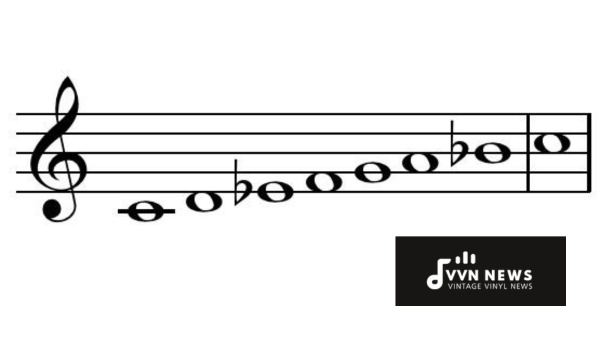From the moment our fingers first find their home on a musical instrument and we pluck, strum, or press to summon those initial euphonic notes, the foundation of our musical journey begins to take shape.
Behind the music that moves us are the underlying scales, each with its unique place in creating emotional expression.
The Dorian mode is one such scale; it is endowed with a soulful character capable of imprinting memorable impressions.
You might wonder why you should care about something seemingly as esoteric as the Dorian mode.
But believe me, this knowledge can open up new vistas in your musical abilities and appreciation.
Even if you’re not writing tunes or playing an instrument personally, understanding scales like these can add depth to your music-listening experience, too.
So buckle up as we venture into the world of music theory’s beautiful Dorian mode!
What are Musical Modes?
Musical modes are essentially scales, each with a special set of intervals that exude a unique sonic personality.
Originating from ancient Greece, the seven diatonic musical modes are Ionian, Dorian, Phrygian, Lydian, Mixolydian, Aeolian, and Locrian.
A distinctive order of whole and half steps determines each mode.
The richness produced by these variations extends the musical palette beyond major and minor scales – offering alternate tonal treasures for both listeners and performers.
Therefore, modes fuel music with diverse flavors – from the joyful brightness of Ionian to the gloomy depth of Aeolian and the distinct character of our topic at hand – Dorian.
Also Read: A Major Scale [The Key To Bright, Cheerful Musical Pieces]
What Is The Dorian Mode?
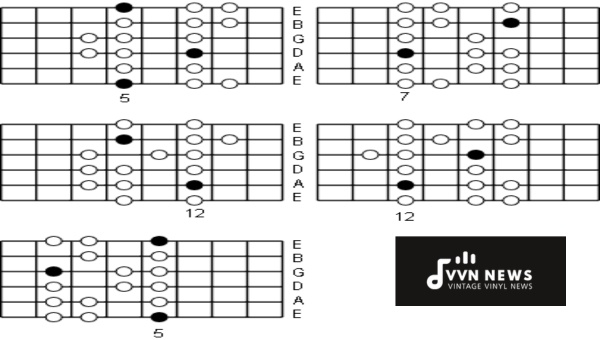
The Dorian mode is the second of the seven musical modes. It’s similar to the natural minor scale, except its sixth note is a whole step higher.
To visualize it on the piano, you would see that it begins on D and includes all white keys up to the next D.
This results in the pattern: whole, half, whole, whole, whole, half, and again a whole step between notes.
Hence, providing its unique melancholic yet somewhat uplifting sound. Famous artists like Miles Davis and Carlos Santana have composed beautiful pieces making use of this poignant sonic scale.
The flexibility of this mode leaves room for creativity and innovation in music composition.
How does the major scale become Dorian Mode?
The Dorian mode, as a derivative of a major scale, follows a specific pattern.
While every scale in Western music consists of seven different tonal degrees, the key factor that differentiates one mode from another lies in the arrangement of these degrees.
To effectively convert a major scale into the Dorian mode, we manipulate the intervals between these degrees through a particular method:
Step-by-Step Transformation
- Commence with the major scale structure. This typically follows the pattern: whole, whole, half, whole, whole, whole, half.
- The Dorian mode instead uses this pattern: whole, half, whole, whole, whole, half, and closing with a complete step at the end.
- In numbers, this can be represented as Major Scale – 1 2 3 4 5 6 7 (intervals W-W-H-W-W-W-H), Dorian Mode – 1 2 b3 4 5 6 b7 (W-H-W-W-W-W-W).
Knowing how to convert scales like this is invaluable for any musician seeking to explore various musical landscapes.
For each major scale out there exists an equivalent Dorian mode.
Degrees of the Dorian Mode
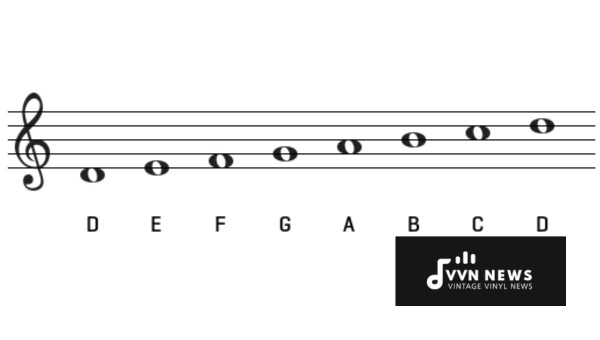
The Dorian mode, distinguished by its beautiful and complex tone, comprises different degrees.
To fully comprehend the composition of this music mode, let’s take a deep dive into each degree that makes up the Dorian:
- Root: An integral part of any musical scale, it serves as the foundation around which the other notes revolve. In the context of our Dorian exploration, it’s paramount to kick-start your musical journey from here.
- Major Second: Just one step up from the root in our scale, Major Second adds an interesting layer to the melodic fabric. Bear in mind, despite being a crucial element in any major scale, it has a different impact on the Dorian mode owing to the other notes at play.
- Minor Third: Here is where we wander into minor territory. It is this note that provides that signature mournful tone associated with minor scales. Slightly altering this can change your tune distinctly!
- Perfect Fourth and Fifth: These two comprise what we often refer to as “perfect” intervals in music. They bring stability and strength into our melody – imagine them as anchors keeping our song steady.
- Major Sixth: Now here’s where things spice up! The inclusion of this note denotes an intriguing modification in typical minor scales pattern– giving Dorian its unique characteristic sound.
- Minor Seventh: Wrapping up our scale line-up is the minor seventh – it brings completion and balance while maintaining that seductive gloomy aura inherent in minor keys.
By using these degrees, you’re playing in the Dorian mode, giving your compositions an entirely different flavor compared to what a major or natural minor scale would provide.
The secret lies not merely in the notes themselves; it’s the combination, sequence, and variance that form this auditory feast called Dorian mode.
Also Read: Phrygian Mode [Adding Exotic Flair To Your Musical Compositions]
The Dorian Mode vs The Natural Minor Scale
Both the Dorian mode and the natural minor scale—also referred to as the Aeolian mode—have their place in music composition, invoking different moods and emotions.
Yet, while they share some similarities, there are key differences that set them apart:
- The Structure: The essential dissimilarity lies in their structure or intervals. Both scales are comprised of seven notes, they differ at the sixth note: Dorian mode raises this a half-step compared to the natural minor scale. So on a Dorian scale, you get a major sixth instead of a minor one.
- Influence: This alteration greatly influences the mood each scale projects. While the natural minor scale conveys profound sorrow and melancholy feelings, the major sixth adds brightness to the darker tones of the Dorian mode.
- Harmony: When we consider harmony, specifically diatonic triads (three-note chords), we find further distinctions associated with that raised sixth note. In Dorian mode, this results in a major IV chord – something not seen in a natural minor scale.
- Use: Another point of differentiation can be seen regarding usage within different musical genres. While both scales are used across all genres of music, Jazz musicians tend to favor Dorian due to its jazzy blues vibe.
- Famous Compositions: Some famous compositions showcase these differences brilliantly; for instance, consider ‘Eleanor Rigby’ by The Beatles which is written in Dorian Mode, and compare it with ‘Black Magic Woman’ by Santana which uses the Natural Minor Scale.
By examining these points, one can gain an appreciation for these scales’ subtly different characteristics that make them unique forces within music theory.
Relationship between Dorian Mode and Major Scales
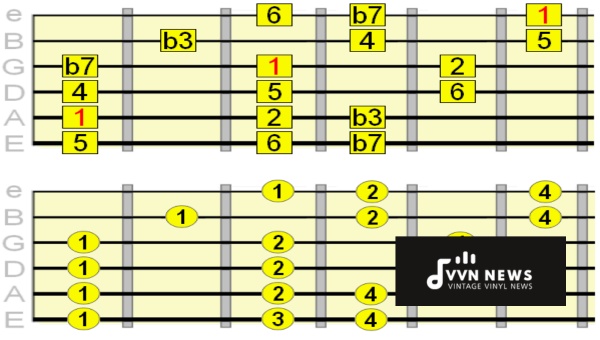
The Dorian mode and major scales, while sounding distinctively different, share a foundation that is deeply rooted in the structure of intervals.
Let me bring forth some key points that should assist you in discerning their relationship.
- Scale Construction: Both major scales and the Dorian mode are created using a specific sequence of whole steps and half steps. These sequences form the unique sonic character of each scale.
- Starting Point: The Dorian mode is technically a major scale starting from the second note or degree of the major scale. For instance, if C Major is your starting point (C, D, E, F, G, A, B), Dorian begins on the second note ‘D’ (D, E, F, G, A, B, C).
- Tonal Quality: Major scales generally have a happy or bright tonal quality while the Dorian mode often carries a more somber or jazzy mood due to its minor third interval.
- Note Relation: Every single tone in the Dorian scale corresponds exactly to a note in its relative major.
- Chord Progressions: Chords derived from both major scales and Dorian modes can be utilized interchangeably within compositions, creating novel harmonic textures
If you look at it this way, major scales and modes like the Dorian are two faces of a miraculous musical coin!
Exploring them can breathe fresh vibrance into your creative endeavors.
Also Read: Mixolydian Mode [Add Depth & Richness To Your Music Today]
Playing the Dorian Scale on Different Instruments
The rich depth of the Dorian mode makes it adaptable for a variety of instruments.
Whether you’re a self-confessed strummer or a passionate pianist, there are specific routes to effectively navigate this engaging scale.
Guitar
If the guitar is your instrument of choice, becoming proficient in the Dorian mode requires committing chord shapes to memory and practicing regularly. It’s an exciting learning phase!
Follow these steps:
- Step 1: Start on the second fret (the note will be E) using either your second or third finger.
- Step 2: Go to the next string down and play frets 1-3.
- Step 3: Proceed to the following string and play frets 1-3 again.
- Step 4: Press on to the next two strings playing frets 2-4.
- Finally, for your high E string, go back and end with playing frets 1-3.
Piano
If you find yourself in front of piano keys instead, here’s how you can dash off a lively tune in Dorian mode:
Apply these instructions:
- Start playing from ‘D’ (this initial note differentiates Dorian mode from others).
- Continue with ‘E,’ move over to ‘F,’ then onto ‘A,’ and finally ease into ‘B.’
- The lesser-known notes like F or C should be played as they are – no need for any flats or sharps!
Learning any new scale takes patience. Ingraining this newfound knowledge into your muscle memory is key.
It also breeds familiarity with various harmonies – allowing you to play songs effortlessly, just like your favorite artist.
Famous Dorian Compositions
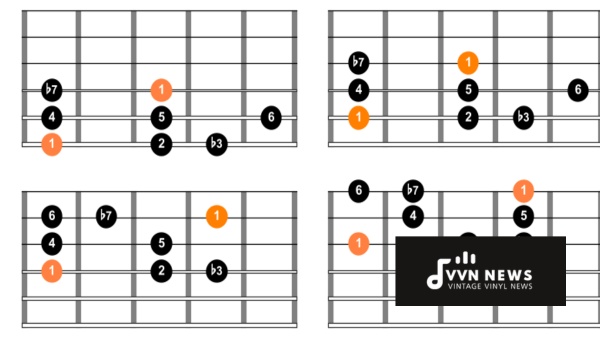
Music percolates through every culture and era, and interestingly, countless chart-toppers have weaved the Dorian mode into their melodies.
Below are five remarkable examples that beautifully incorporate this venerable scale.
- “Scarborough Fair” by Simon & Garfunkel: Originating from an old English ballad, this timeless classic is a pristine example of the Dorian mode. The way the melody glides over the notes of E Dorian truly encapsulates its soulful vibe.
- “Miles” by Miles Davis: Miles Davis was a jazz virtuoso. His song “Miles,” an interpretation of a 16-bar composition aptly named ‘So What,’ primarily uses the Dorian mode on two separate tonal centers, thereby cementing its place in musical history as a prime exemplar of modal jazz.
- “Moondance” by Van Morrison: This dreamy composition in A Dorian demonstrates how this modal key can establish an enchanting mood perfect for a moonlit dance.
- “Eleanor Rigby” by The Beatles: Renowned worldwide, this composition uses multiple modes to create varying emotions throughout different verses – yet it’s primarily based on E minor (a key related to Dorian).
- “Wicked Game” by Chris Isaak: This ethereal track makes excellent use of B Dorian to underline its hauntingly melancholic yet achingly beautiful story.
These tracks demonstrate how the distinct ethos inflected by the minor-major tension of Dorian mode plays into distinctive moods intrinsically woven within compelling narratives artistically expressed through music.
From pop-rock bops to hauntingly captivating ballads, these examples underscore that any genre can effectively employ and benefit from exploiting Dorian modulations.
Modes in the Dorian Scale
The Dorian Mode, a member of the diatonic scale family, is formed by starting a major scale on its second degree.
This gives it a distinctive tonality, characterized by its minor third and major sixth intervals.
To help you comprehend the concept, here are all twelve instances of the Dorian mode:
- C dorian mode – C D Eb F G A Bb C
- C# dorian mode – C# D# E F# G# A# B C#
- Db dorian mode – Db Eb Fb Gb Ab Bb Cb Db
- D dorian mode – D E F G A B C D
- D# dorian mode – D# E# F# G# A# B# C# D#
- Eb dorian mode – Eb F Gb Ab Bb C Db Eb
- E dorian mode – E F# G A B C# D E
- F dorian mode – F G Ab Bb C D Eb F
- F# dorian mode – F# G# A B C# D# E F#
- Gb dorian mode – Gb Ab Bbb Cb Db Eb Fb Gb
- G dorian mode – G A Bb C D E F G
- G# dorian mode – G# A# B C# D# E# F# G#
- Ab dorian mode – Ab Bb Cb Db Eb F Gb Ab
- A dorian mode – A B C D E F# G A
- Bb dorian mode – Bb C Db Eb F G Ab Bb
- B dorian mode – B C# D E F# G# A B
Each mode has its character, but the Dorian mode’s particular sound stands between major and minor – not too happy, not too sad – lending itself well to various genres including jazz, rock, or pop.
FAQs About The Dorian Scales
What exactly is the Dorian mode?
The Dorian mode is one of the seven diatonic scales (modes) in Western music theory. It consists of two minor thirds, making its sound minor, and is often used in jazz, blues, and rock music.
Is Dorian mode major or minor?
Effectively, the Dorian mode is a type of minor scale due to its flat third feature. It has a major 6th instead of the minor 6th found in natural minor scales giving it a unique characteristic sound.
What genres commonly use the Dorian mode?
Though found across different musical genres Dorian is predominantly used in jazz, folk, blues and rock for its uniquely expressive character.
How do I identify if a song is written in the Dorian mode?
Identifying Dorian may require attentive listening skills and some of musical scales. Usually, songs written in this scale will have a ‘minor’ feel, but will feature a raised 6th note that lends an expressive tone.
Do I need to learn all modes before learning Dorian?
While modes can enhance your overall musical knowledge and skill-set as they are interdependent to some extent, you don’t necessarily have to master all modes prior to learning about the Dorian.
Conclusion
The Dorian mode is a magical journey into the depth of music theory that fascinates and enriches our knowledge of music.
Whether you’re an avid listener or an accomplished musician, it’s something truly deserving your attention.
Every scale, every mode has its unique resonance and emotion, and harnessing these can unlock unexplored dimensions in your musical repertoire or appreciations.
Intimidating at first glance, a deeper concepts like this is sure to add another layer of enjoyment to the beautiful mosaic of sounds we call music!
